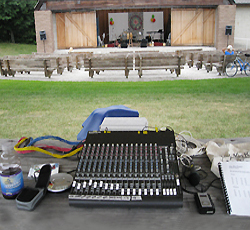The sound check is critical – if well done, it gives the band confidence in you so they can relax and just play. And when you give the band the monitor mixes they need, they perform better.
In this process, first you do a line check. Are all the mics and DIs connected to the right inputs and working okay? Then you do a sound check: set the levels, EQ and mix, with the goal of everything sounding great when the performance starts.
I’ll offer some tips to help this procedure go smoothly.
LINE CHECK
Let’s say you have a stage plot and a mic input list. Place one copy of your list near the stage box, and another near the mixing console to label the faders.
Plug in mics and direct boxes according to the list, and listen to each channel one at a time over the house loudspeakers.
Note: In situations such as live music festivals, solo each channel and monitor it over headphones to avoid disturbing the audience.
Should you check each mic and DI as it’s plugged in? Or should you connect everything first, then check each channel?
If you check a mic as you plug it in, you know immediately where any problem lies. If you check channels after all the mics are connected, you have to troubleshoot the channels (mute or solo each channel) if you hear a problem.
Checking as you plug in works best if you have one technician on stage and one at the mixer.
But if you’re doing the whole thing – mic’ing and mixing – plug all the mics in and then do a line check. If you hear a noise over the house loudspeakers, mute each channel one at a time and see when the noise stops. Or solo each channel and listen for the noise.
Before the performers arrive on stage, have a helper talk into each mic and identify it. If guitars with pickups are on stage, turn up their volume control and strum each instrument (with the musician’s permission).
Turn up the channel input trim and fader slowly to avoid feedback. Listen for signals and note any issues.
Here are some problems you may hear during a line check, and some fixes to try:
No Signal
• The mic is plugged into the wrong channel as specified on the input list. Check the connection.
• The snake XLR connector is plugged into the wrong-numbered input. Check it.
• The channel is muted, or is not routed to an output bus.
• Make sure the musician’s volume controls are turned up in their entire signal chain.
• Try other guitar cords and mic cables.
• Replace dead batteries.
• Is phantom switched on in the dead channel? Condenser mics and some direct boxes require phantom power.















